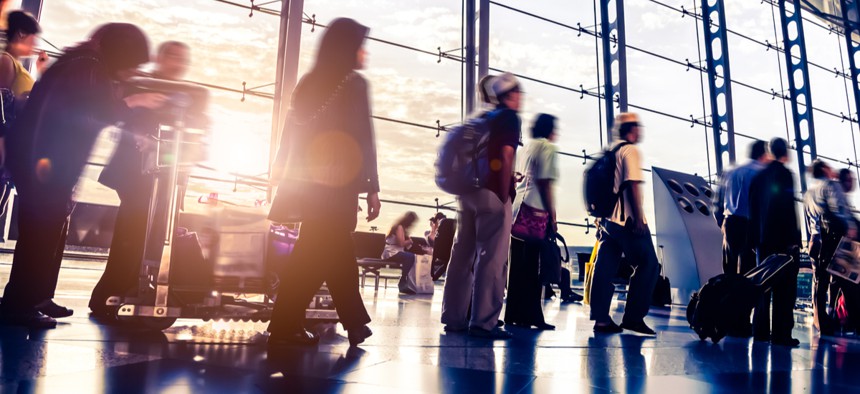Survey: U.S. Air Travelers Approve of Biometric Identification

06photo/Shutterstock.com
A large majority of respondents said they are willing to give up their biometric data—when they perceive a security benefit.
United States travelers “strongly support” using biometrics to make airport experiences more convenient and secure, according to Unysis’ 2019 Security Index survey released Wednesday.
As Unisys’ twelfth annual index, the report provides global insights into customers’ concerns about security. The company conducted online surveys of at least 1,000 adults in each of the participating 13 countries, including the U.S., earlier this year.
The results suggest 80% of air travelers are willing to give their biometric data to the airport or government.
“This is something that did not register at all just a couple years ago,” Unisys’ Chief Trust Officer Tom Patterson said at a panel the company hosted in Washington. “Now we are seeing an overwhelming number of U.S. respondents that want to use biometrics at the airport.”
U.S. respondents were split on reasons why they were pro biometrics: 42% said they’re willing because they think it’ll make flights safer and help with terrorism prevention, 35% said it’s because biometrics are more reliable than legacy forms of identification like licenses, 33% were supportive because they believe authorities should know the people in airports at all times and 32% said they’re supportive if the tech will get them through the airport faster.
“I’ll tell you, I've been using biometrics in airports throughout the world for the last five or six years—my line is always shortest,” Patterson said.
But he also highlighted that respondents were supportive of the emerging technology specifically when they perceive an actual security benefit or a tool that enhances convenience. They were less supportive of biometrics use around consumerism or to sell them the latest products.
“That was clear: They will accept biometrics but if it’s for their safety and security,” Patterson said.
Of the 20% of respondents who said they are not willing to share biometric data with airports or the government, the majority said it’s because they do not trust the government or airports to possess their data, and that they were concerned their information would be lost or hacked.
The concerns aren’t unwarranted. This week Customs and Border Protection announced thousands of images of travelers and license plates were stolen in a “malicious cyber-attack.” Still, two security experts with decades of federal experience said the technology is here to stay.
Peter Ford is GS4 Corporate Risk Services’ director of the Northeast Region, but he also served as a regional security officer in multiple embassies overseas and as the U.S. Olympic Security Coordinator for the Rio de Janeiro Olympic Games, where he worked with local, state, and federal police and other security officials to protect the global event.
In detailing the complex security operations Brazil put in place, Ford said, “I don’t want to say if they were using facial recognition, but I think it’s going to be a thing of the future at all these big events.”
Scott Breor, Cybersecurity and Infrastructure Security Agency’s director of protective security coordination division, provided an overview of the initiatives and materials CISA is developing to support nationwide security. He said we’ll likely continue to see biometrics at large venues but emphasized that experts’ No. 1 priority around security measures is people’s actual experience with the tech.
“We want it to be a positive experience, so every day they are making the decisions based on, ‘well, what is the experience of the individual going through that?’ and with that there is tradeoffs,” Breor said.
Patterson said Unisys also asked respondents where they’d be comfortable with the increased integration of facial recognition. About a third of respondents supported its use in voting stations and at large public gatherings.
“Now with our phones, we’ve gotten used to using first fingerprints and then facial recognition. People are getting used to using biometrics in positive way and they see that,” Patterson said.
In a conversation with reporters, Breor added there is work being done to ensure that as these emerging technologies are implemented to improve security, they aren’t simultaneously making individuals more vulnerable to privacy and cybersecurity threats.
“Anything you put in place, you have to understand the vulnerabilities of that technology and then do what you can to mitigate them,” he said.
NEXT STORY: The Wild-West Era of Streaming TV Is Ending






